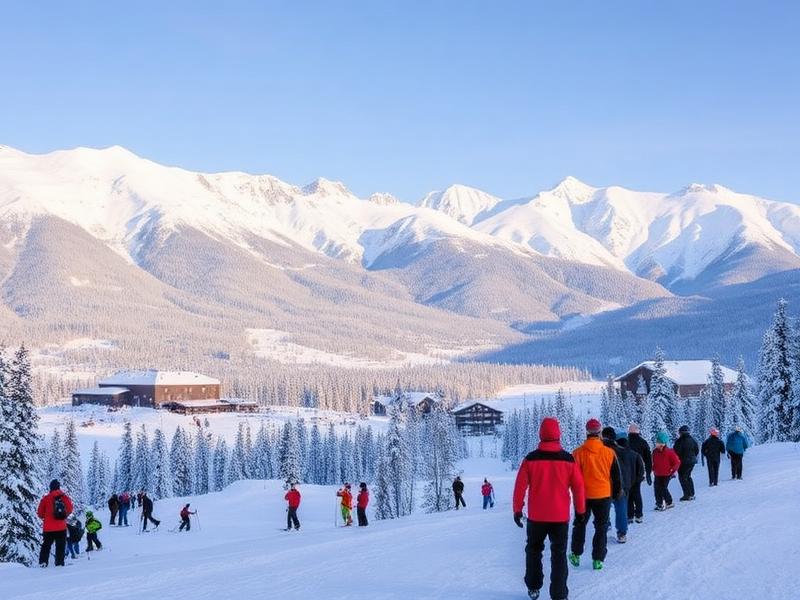Canada's winter tourism industry is experiencing an unprecedented boom, with the 2024-25 season delivering record-breaking performance across all major metrics. Total winter tourism revenue has reached $4.2 billion, marking a 23% increase from the previous season and surpassing pre-pandemic levels by 8%. This remarkable recovery is driven by exceptional snow conditions, enhanced resort facilities, and a surge in both domestic and international visitor interest.
Ski Resort Renaissance
Canadian ski resorts are reporting their strongest performance in over a decade, with many destinations achieving 95% capacity throughout the peak winter months. Whistler Blackcomb, Banff's ski areas, and Quebec's Laurentian resorts have all posted record visitor numbers, supported by exceptional snow conditions and significant infrastructure investments.
Top Performing Winter Destinations
International Visitor Surge
International arrivals have been a particular bright spot, with visitors from the United States increasing by 31% compared to last season. European markets, led by Germany, France, and the United Kingdom, have shown remarkable growth of 45%, as travelers seek authentic winter experiences and value for money compared to traditional Alpine destinations.
International Market Performance
Hospitality Sector Recovery
Hotels, lodges, and vacation rental properties across major winter destinations are reporting exceptional occupancy rates and revenue per available room (RevPAR) figures. The hospitality sector's performance has exceeded industry forecasts, with many properties booked solid through March 2025.
Hospitality Performance Highlights
- Fairmont Chateau Whistler: 98% occupancy, $450 average daily rate
- Fairmont Banff Springs: 96% occupancy, $385 average daily rate
- Fairmont Le Château Frontenac: 94% occupancy, $295 average daily rate
- Blue Mountain Resort: 92% occupancy, $320 average daily rate
Employment and Economic Impact
The winter tourism boom has created approximately 45,000 seasonal jobs across Canada, providing crucial employment opportunities in mountain communities and rural areas. Many resorts report difficulty finding sufficient staff to meet demand, leading to wage increases and enhanced benefit packages for hospitality workers.
Economic Impact by Region
Infrastructure and Investment
Significant capital investments in resort infrastructure have contributed to the sector's success. Over $890 million has been invested in lift upgrades, snowmaking systems, accommodation expansions, and guest experience enhancements across major Canadian winter destinations over the past three years.
Technology and Guest Experience
Digital innovation has played a crucial role in enhancing visitor experiences and operational efficiency. Mobile lift ticket purchasing, real-time slope condition updates, and contactless payment systems have become standard across major resorts, improving guest satisfaction and reducing wait times.
Digital Innovation Trends
- Mobile Lift Tickets: 78% of visitors use digital ticketing
- RFID Technology: Seamless mountain access and tracking
- Real-time Apps: Live slope conditions and wait times
- Contactless Dining: QR code menus and mobile ordering
- AI-Powered Recommendations: Personalized activity suggestions
Climate Considerations and Sustainability
Despite concerns about climate change impacts on winter sports, the 2024-25 season has benefited from exceptional natural snowfall across most Canadian mountain regions. However, resort operators continue to invest heavily in snowmaking technology and sustainable practices to ensure long-term viability.
Domestic Tourism Strength
Canadian domestic tourism has shown remarkable resilience, with inter-provincial winter travel increasing by 19% compared to the previous season. This growth reflects both increased disposable income among Canadian families and a renewed appreciation for domestic travel experiences.
The "staycation" trend has particularly benefited destinations within driving distance of major urban centers. Ontario's Blue Mountain, Quebec's Laurentian resorts, and Alberta's Kananaskis region have all seen substantial increases in weekend and short-term visitors from nearby cities.
Challenges and Opportunities
While the current boom presents tremendous opportunities, it also creates challenges including staff shortages, infrastructure strain, and environmental pressures. Resort operators are working collaboratively with government agencies to address these issues while maintaining service quality.
Looking Ahead: Spring and Summer Prospects
The success of the winter season has created optimism for year-round mountain tourism. Many resorts are already reporting strong advance bookings for summer activities including mountain biking, hiking, and outdoor festivals, suggesting the tourism recovery extends beyond winter sports.
Industry analysts project that the momentum from this exceptional winter season will contribute to a broader tourism sector recovery, with potential spillover benefits for urban destinations and other tourism segments throughout 2025.
Government Support and Policy
Federal and provincial government support programs have contributed significantly to the sector's recovery. The Tourism Recovery Fund and enhanced worker mobility programs have helped destinations rebuild capacity and attract international visitors through targeted marketing campaigns.
Government Support Impact
As the 2024-25 winter season concludes, the Canadian tourism industry can celebrate not just recovery, but transformation. The sector has emerged more resilient, technologically advanced, and environmentally conscious than before, positioning Canada as a premier global winter destination for years to come.
The winter tourism boom represents more than statistical success—it demonstrates the enduring appeal of Canada's natural winter wonderlands and the industry's ability to adapt, innovate, and thrive in challenging circumstances. As planning begins for the 2025-26 season, industry leaders remain optimistic about sustained growth and continued excellence in winter hospitality.
